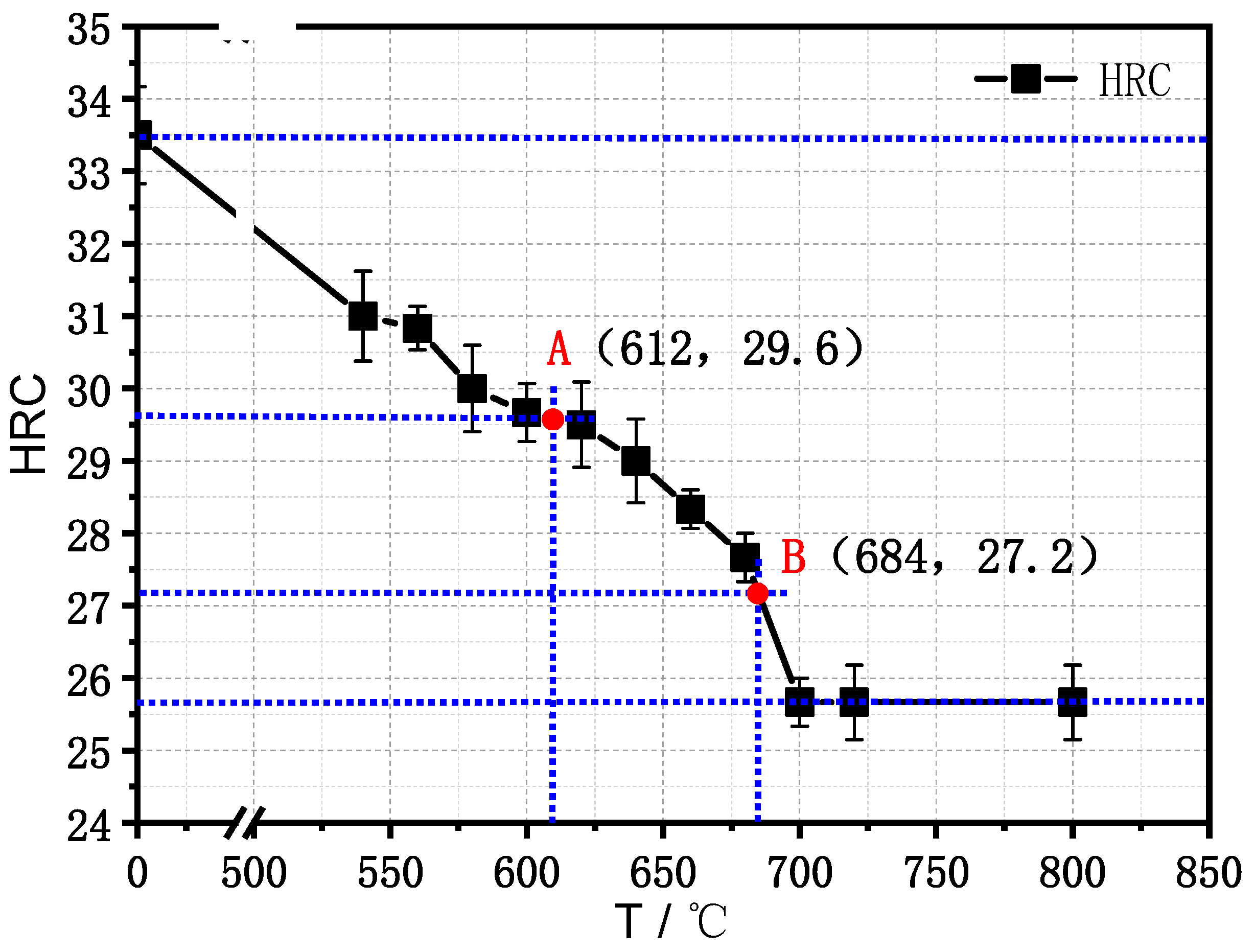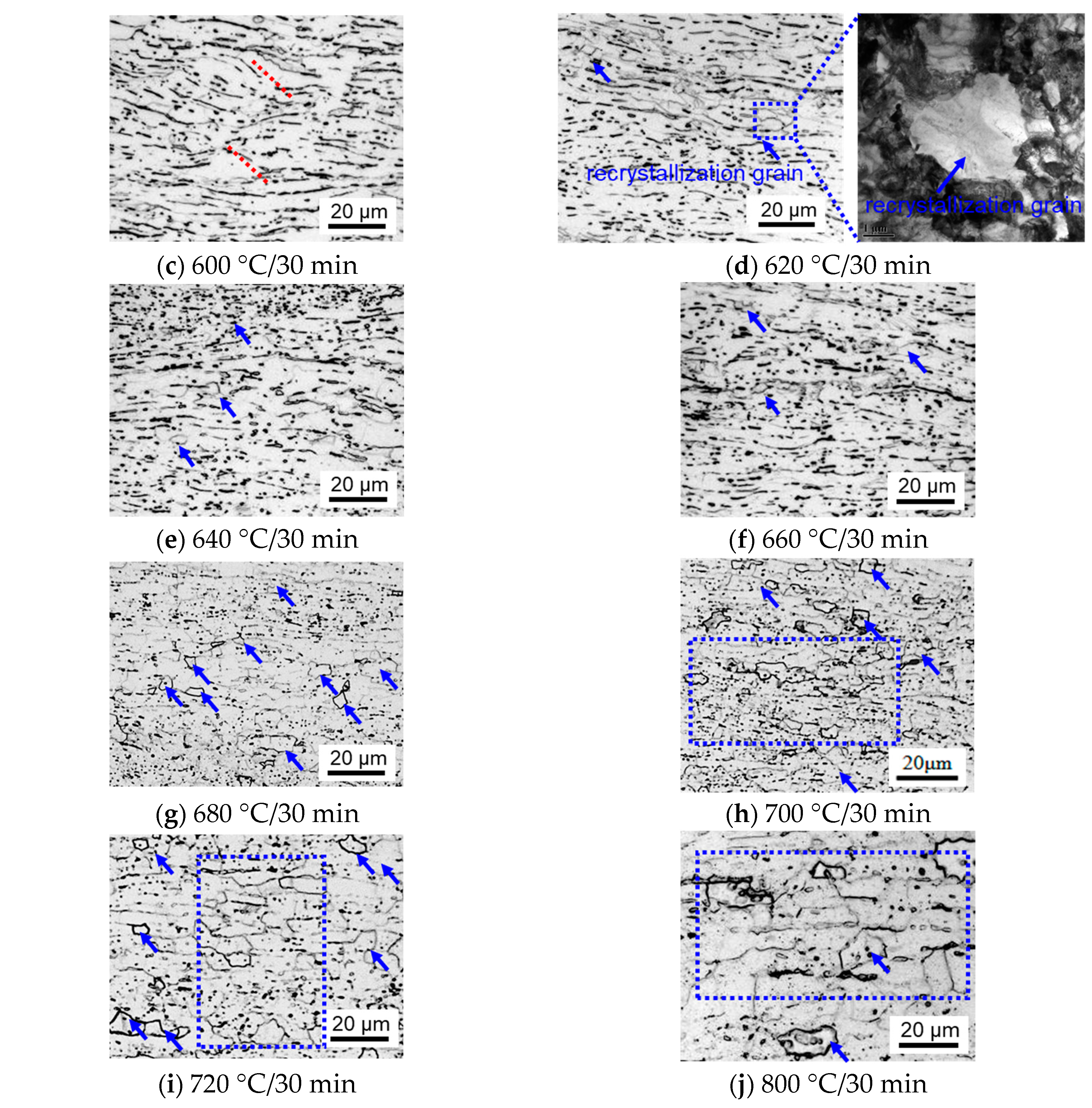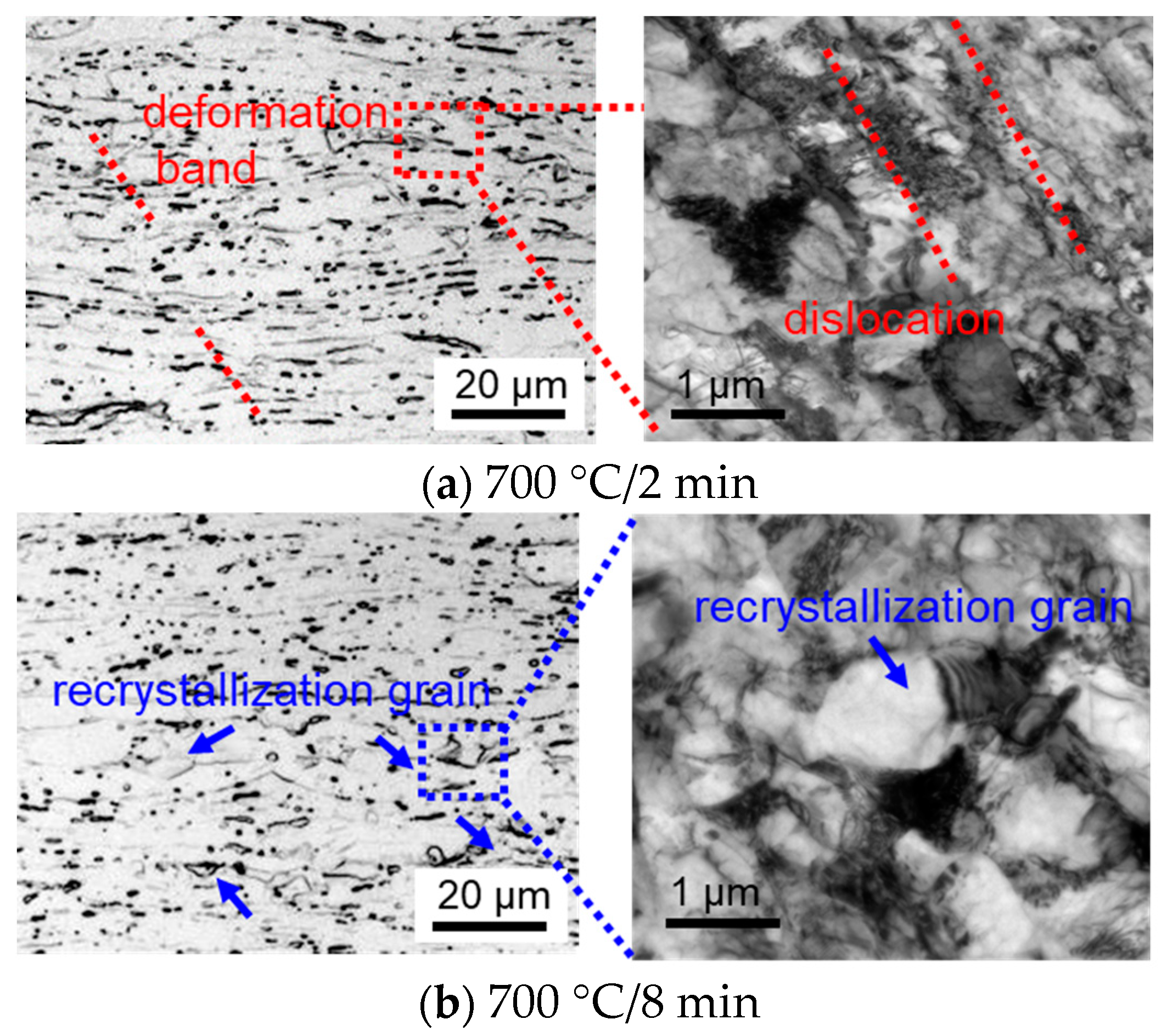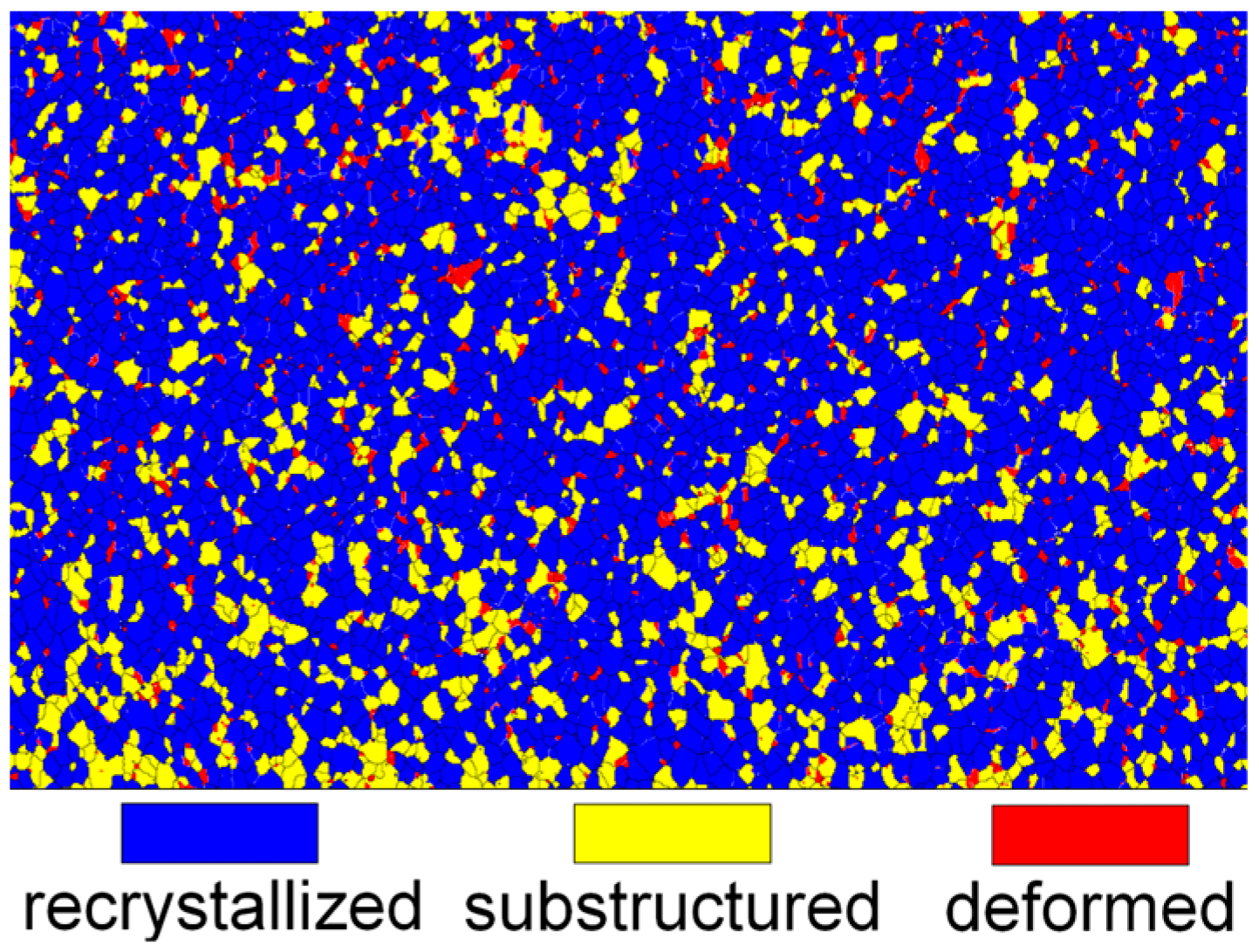Research on the Recrystallization Process of the Ti-70 Titanium Alloy Sheet
Abstract
:1. Introduction
2. Materials and Methods
3. Result and Discussion
3.1. Calculation of the Recrystallization Temperature of Ti-70 Alloy Sheets through the “Hardness Method”
3.2. Microstructure of the Ti-70 Alloy Sheet after Different Heat Treatment Processes
3.2.1. Annealing Microstructure at Different Temperatures for 30 min
3.2.2. Annealing Microstructure at 700 °C for Different Amounts of Time
3.3. Tensile Properties of the Ti-70 Alloy Sheet after Different Heat Treatment Processes
4. Conclusions
- (1)
- Cold-rolled Ti-70 alloy sheets have a recrystallization activation energy Qr = 11.0645 × 104 J/mol and coefficient A = 1920 s−1. Hence, the Avrami relation formula between the annealing temperature and time is:
- (2)
- The recrystallization process is completed in the temperature range of 680~700 °C for 30 min. The uniform and equiaxed recrystallization structure can be obtained, and the recrystallization volume fraction can reach up to 82%.
- (3)
- When the cold-rolled Ti-70 alloy sheet is annealed at 700 °C, recrystallization grains begin to appear within 8 min. The recrystallization process is completed at the holding time of 30~60 min and the average grain size is about 8.2 μm.
- (4)
- The ultimate tensile strength can be controlled between approximately 705 and 852 MPa, the yield strength can be controlled between approximately 623 and 793 MPa, and the elongation percentage (A) can be controlled between approximately 10.0 and 25.0% after rolling and heat treatment of the Ti-70 alloy sheet.
Author Contributions
Funding
Data Availability Statement
Acknowledgments
Conflicts of Interest
References
- Hui, W.; Yan, S. Electrochemical Corrosion Behavior of Ti70 Alloy in HF-HNO3 System. Corros. Prot. 2013, 34, 914–917. [Google Scholar]
- Lv, L.; Xi, J.; Wang, W. Development status and prospect on application of titanium alloy in ocean engineering. Metall. Eng. 2015, 2, 89–92. [Google Scholar]
- Shen, L.H.; Zhu, B.H.; Liu, Y.C.; Yuan, H.J.; Wang, P.J.; Chen, R.B.; Liu, S.T. Effects of forging process on microstructure and property of TA23 alloy. Titanium 2013, 30, 27–31. [Google Scholar]
- Yu, W.; Li, Y.; Cao, J. The dynamic compressive behavior and constitutive models of a near α TA23 titanium alloy. Mater. Today Commun. 2021, 29, 102863. [Google Scholar] [CrossRef]
- Zhang, Z.X.; Li, R.F.; Wang, J.; Wang, Q.B. Effects of test temperature on impact toughness of Ti-70 Titanium plate. World Nonferrous Met. 2017, 4, 1–3. [Google Scholar]
- Wang, D.; Wang, S.; Zhang, W. Microstructural Evolution and Mechanical Properties of Electron Beam-Welded Ti70/TA5 Dissimilar Joint. J. Eng. Mater. Technol. 2021, 143, 021002. [Google Scholar] [CrossRef]
- Hao, X.; Liu, Y.; Li, B. Corrosion behavior of marine Ti70 alloy in artificial seawater. Corros. Sci. Prot. Technol. 2019, 31, 27–32. [Google Scholar]
- Wang, D.; Wang, S.; Zhang, W. Numerical Simulation and Experimental Investigation on Ti70 Titanium Alloy Electron-Beam-Welded Joint. Trans. Indian Inst. Met. 2020, 73, 2361–2369. [Google Scholar] [CrossRef]
- Dixit, S.; Kumar, D.; Dash, B.B. Effect of solutionizing temperature and cooling rate on phase morphology, recrystallization and texture evolution in a heat treated Ti-6Al-4Valloy having different types of microstructure. J. Alloys Compd. 2022, 927, 166897. [Google Scholar] [CrossRef]
- Sobotka, E.; Kreyca, J.; Kahlenberg, R. Analysis of Recrystallization Kinetics Concerning the Experimental, Computational, and Empirical Evaluation of Critical Temperatures for Static Recrystallization in Nb, Ti, and V Microalloyed Steels. Metals 2023, 13, 884. [Google Scholar] [CrossRef]
- Gupta, A.; Khatirkar, R.; Singh, J. A review of microstructure and texture evolution during plastic deformation and heat treatment of β-Ti alloys. J. Alloys Compd. 2022, 899, 163242. [Google Scholar] [CrossRef]
- Ghaderi, A.; Hodgson, P.D.; Barnett, M.R. Microstructure and texture development in Ti-5Al-5Mo-5V-3Cr alloy during cold rolling and annealing. Key Eng. Mater. 2013, 551, 210–216. [Google Scholar] [CrossRef]
- Mironov, S.; Zherebtsov, S.; Semiatin, S.L. The grain-refinement mechanism during heavy cold-rolling of commercial-purity titanium. J. Alloys Compd. 2022, 895, 162689. [Google Scholar] [CrossRef]
- Kikuchi, S.; Ueno, A.; Akebono, H. Combined effects of low temperature nitriding and cold rolling on fatigue properties of commercially pure titanium. Int. J. Fatigue 2020, 139, 105772. [Google Scholar] [CrossRef]
- Zhao, S.; Yang, W.; Lin, P. Effect of annealing temperature on microstructure and mechanical properties of cold-rolled commercially pure titanium sheets. Trans. Nonferrous Met. Soc. China 2020, 32, 2587–2597. [Google Scholar] [CrossRef]
- Choi, S.W.; Won, J.W.; Lee, S. A novel cryogenic rolling method for commercially pure titanium sheets featuring high strength and ductility. J. Alloys Compd. 2022, 928, 167191. [Google Scholar] [CrossRef]
- Liu, Y.Q.; Meng, X.J.; Liao, Z.Q.; Yu, W.; Li, Q.M.; Wang, X.P. Properties of a new shipbuilding cold-working alloy Ti-70. Acta Metall. Sin. 2002, 38, 264–266. [Google Scholar]
- Zhang, Z.X.; Li, R.F.; Chen, H.T.; Wang, J.; Wang, Q.B. Failure Analysis of Bending Fracture of Ti-70 Titanium Alloy Sheet. Met. Work. 2018, 10, 43–45. [Google Scholar]
- Xu, Q.L.; Lin, D.W.; Wang, M.; Gan, Q.S. Measurement of Recrystallization Temperature of Cold Rolled High Strength IF Steel. Met. Heat-Treat. 2007, 32, 14–16. [Google Scholar]
- Duan, X.G.; Jiang, H.T.; Liu, J.X.; Bi, Y.J. Recrystallization Process of Commercial Pure Titanium Cold Rolled Sheet. Chin. J. Rare Met. 2012, 36, 353–357. [Google Scholar]
- Xu, Q.-L. Research on Re-Crystallization Temperature of IF Steel. Master’s Thesis, Shanghai Univercity, Shanghai, China, 2008. [Google Scholar]
- GB/T 231.1-2009; Metallic Materials-Brinell Hardness Test-Part 1: Test Method. China National Standardization Management Committee: Bejing, China, 2009.
- Gai, Y.; Lun, J.J. Physical Metallurgy Principle; Mechanical Industry Press: Beijing, China, 1981; p. 152. [Google Scholar]
- GB/T 228.2-2015; Metallic Materials-Tensile Testing Part 2: Method of Test at Elevated Temperature. China National Standardization Management Committee: Bejing, China, 2015.
- GB/T 229-1994; Metallic Materials-Charpy Notch Impact Test. China National Standardization Management Committee: Bejing, China, 1994.
- Mao, W. Recrytallization and Grain Growth; Metallurgy Industry Press: Beijing, China, 1993; pp. 61–62. [Google Scholar]
- Zhu, Z.; Wang, Q.-J.; Mo, W. Metallography and Heat Treatment of Titanium; Metallurgy Industry Press: Beijing, China, 2014; pp. 208–211. [Google Scholar]
- McQueen, H.J. Development of dynamic recrystallization theory. Mater. Sci. Eng. A 2004, 387, 203–208. [Google Scholar] [CrossRef]
- Prinz, F.; Argon, A.S.; Moffatt, W.C. Recovery of dislocation structures in plastically deformed copper and nickel single crystals. Acta Met. 1982, 30, 821–830. [Google Scholar] [CrossRef]
- Gottstein, G. Recristallisation Metallischer Werkstoffe; DGM-Informations-Gesellschaft: Oberursel, Germany, 1984; pp. 60–77. [Google Scholar]
- Rollett, A.; Humphreys, F.J.; Rohrer, G.S.; Hatherly, M. Deformation Textures in Close Packed Hexagonal (CPH) Metals. Recristallisation and Related Annealing Phenomena; Elsevier: Oxford, UK, 2004; pp. 76–77. [Google Scholar]
- Cao, J.X.; Huang, X.; Liu, S.L.; Yu, H. Effect of heat treatment on microstructure and properties of Ti-6Al-1.5Cr-2.5Mo-0.5Fe-0.3Si alloy. Acta Metall. Sin. 2002, 38, 78–80. [Google Scholar]
- The recrystallized microstructure. In Recristallisation and Related Annealing Phenomena; Elsevier: Oxford, UK, 2004; pp. 248–250.
- Quadir, M.Z.; Duggan, B.J. A microstructural study of the origins of crecrystallization textures in 75% warm rolled IF steel. Acta Mater. 2006, 54, 4337–4350. [Google Scholar] [CrossRef]
- Wroński, M.; Kumar, M.A.; McCabe, R.J. Deformation behavior of CP-titanium under strain path changes: Experiment and crystal plasticity modeling. Int. J. Plast. 2022, 148, 103129. [Google Scholar] [CrossRef]
- Lee, J.R.; Lee, M.S.; Yeon, S.M. Influence of heat treatment and loading direction on compressive deformation behaviour of Ti–6Al–4V ELI fabricated by powder bed fusion additive manufacturing. Mater. Sci. Eng. A 2022, 831, 142258. [Google Scholar] [CrossRef]







| Ti | Al | Zr | Fe | Si | C | N | O |
|---|---|---|---|---|---|---|---|
| bal. | 2.8 | 2.0 | 0.98 | 0.02 | 0.01 | 0.01 | 0.11 |
| bal. | 2.7 | 2.1 | 0.96 | 0.03 | 0.01 | 0.01 | 0.12 |
| Heat Treatment Process | Direction | Rm, MPa | Rp0.2, MPa | A, % |
|---|---|---|---|---|
| Cold-rolled | RD1 | 850 | 790 | 13.0 |
| RD2 | 852 | 793 | 12.0 | |
| RD3 | 848 | 788 | 10.0 | |
| 580 °C/30 min | RD1 | 797 | 691 | 16.5 |
| RD2 | 797 | 696 | 17.5 | |
| RD3 | 791 | 691 | 15.5 | |
| 600 °C/30 min | RD1 | 774 | 670 | 18.5 |
| RD2 | 777 | 672 | 18.0 | |
| RD3 | 777 | 679 | 17.0 | |
| 620 °C/30 min | RD1 | 750 | 663 | 18.0 |
| RD2 | 750 | 660 | 19.0 | |
| RD3 | 755 | 666 | 19.0 | |
| 640 °C/30 min | RD1 | 739 | 659 | 19.9 |
| RD2 | 740 | 653 | 19.8 | |
| RD3 | 745 | 651 | 20.0 | |
| 660 °C/30 min | RD1 | 736 | 642 | 20.5 |
| RD2 | 730 | 645 | 20.0 | |
| RD3 | 737 | 641 | 20.5 | |
| 680 °C/30 min | RD1 | 725 | 632 | 21.0 |
| RD2 | 726 | 639 | 22.5 | |
| RD3 | 728 | 635 | 19.5 | |
| 700 °C/30 min | RD1 | 712 | 634 | 21.0 |
| RD2 | 715 | 626 | 22.5 | |
| RD3 | 717 | 633 | 22.0 | |
| 720 °C/30 min | RD1 | 710 | 623 | 25.0 |
| RD2 | 710 | 628 | 23.0 | |
| RD3 | 705 | 629 | 22.0 |
| Heat Treatment Process | Direction | Rm, MPa | Rp0.2, MPa | A, % | KV2, J |
|---|---|---|---|---|---|
| cold rolled | RD1 | 850 | 790 | 13.0 | 13 |
| RD2 | 852 | 793 | 12.0 | 10 | |
| RD3 | 848 | 788 | 10.0 | 11 | |
| 700 °C/30 min | TD1 | 753 | 716 | 21.5 | 38 |
| TD2 | 745 | 696 | 18.0 | 40 | |
| TD3 | 747 | 708 | 19.0 | 40 | |
| RD1 | 712 | 634 | 21.0 | 28 | |
| RD2 | 715 | 626 | 19.5 | 32 | |
| RD3 | 717 | 633 | 22.0 | 26 |
Disclaimer/Publisher’s Note: The statements, opinions and data contained in all publications are solely those of the individual author(s) and contributor(s) and not of MDPI and/or the editor(s). MDPI and/or the editor(s) disclaim responsibility for any injury to people or property resulting from any ideas, methods, instructions or products referred to in the content. |
© 2023 by the authors. Licensee MDPI, Basel, Switzerland. This article is an open access article distributed under the terms and conditions of the Creative Commons Attribution (CC BY) license (https://creativecommons.org/licenses/by/4.0/).
Share and Cite
Zhang, Z.; Tang, B.; Li, R.; Fan, J.; Li, J. Research on the Recrystallization Process of the Ti-70 Titanium Alloy Sheet. Metals 2023, 13, 1841. https://doi.org/10.3390/met13111841
Zhang Z, Tang B, Li R, Fan J, Li J. Research on the Recrystallization Process of the Ti-70 Titanium Alloy Sheet. Metals. 2023; 13(11):1841. https://doi.org/10.3390/met13111841
Chicago/Turabian StyleZhang, Zhixin, Bin Tang, Ruifeng Li, Jiangkun Fan, and Jinshan Li. 2023. "Research on the Recrystallization Process of the Ti-70 Titanium Alloy Sheet" Metals 13, no. 11: 1841. https://doi.org/10.3390/met13111841
APA StyleZhang, Z., Tang, B., Li, R., Fan, J., & Li, J. (2023). Research on the Recrystallization Process of the Ti-70 Titanium Alloy Sheet. Metals, 13(11), 1841. https://doi.org/10.3390/met13111841








